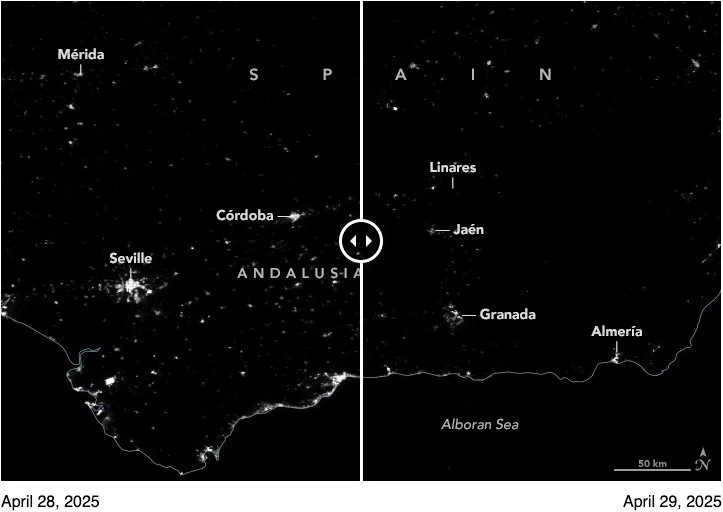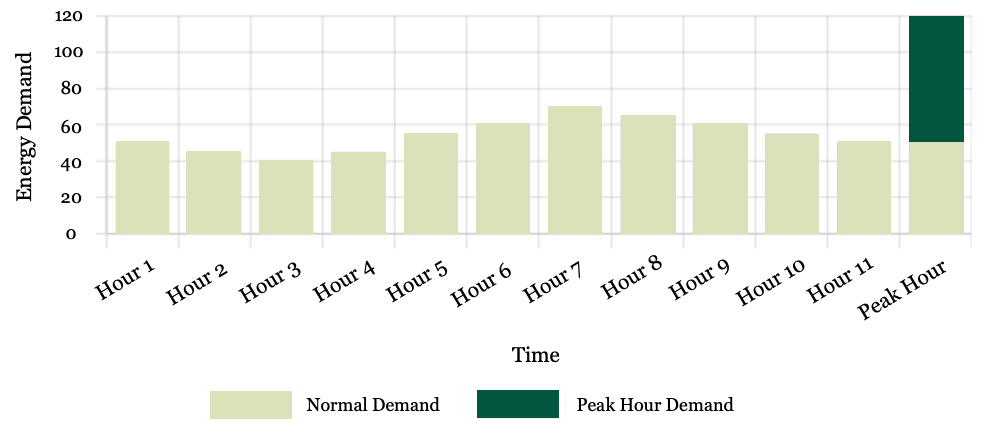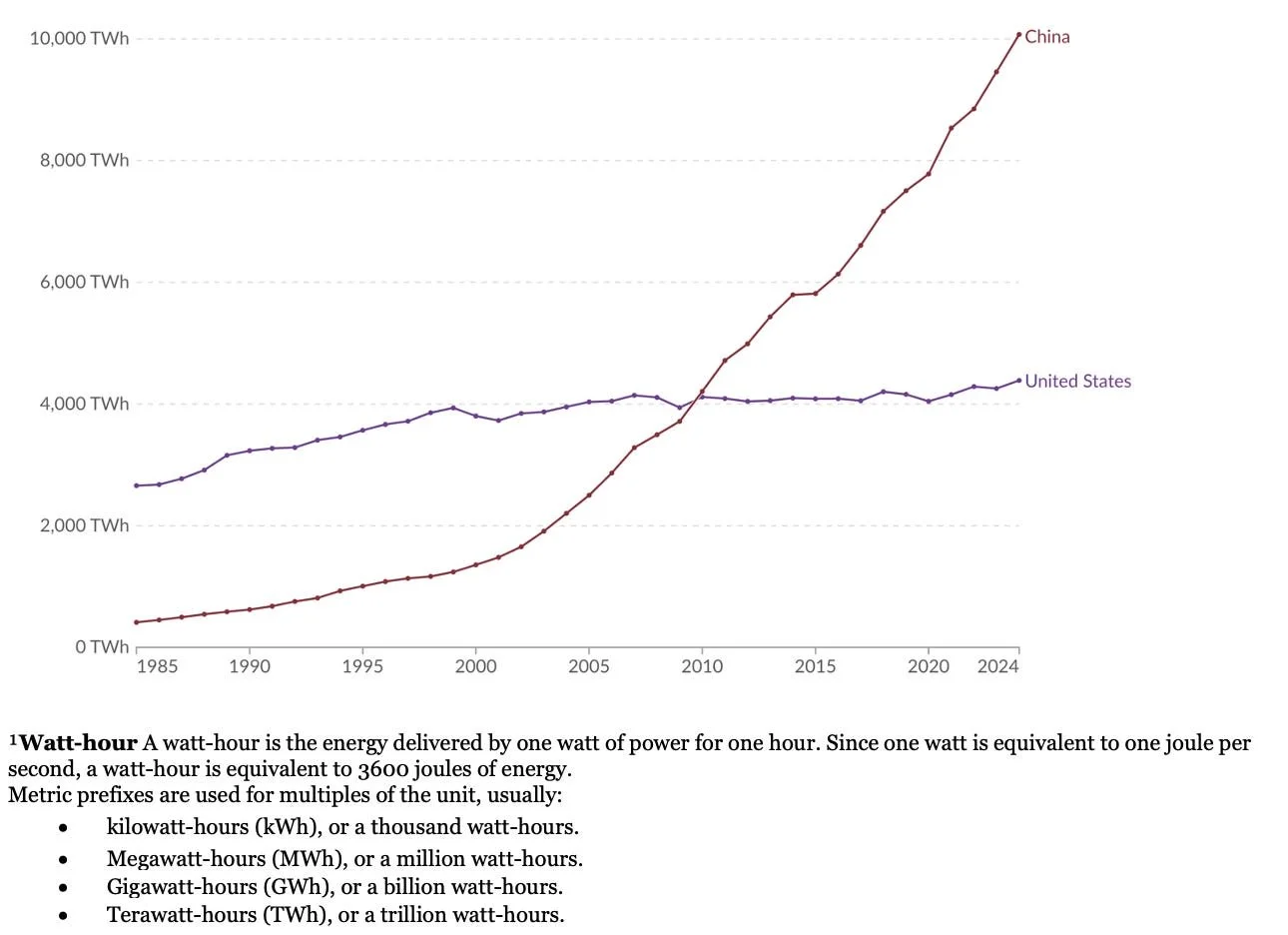The Irrational Pushback Against Renewables
Source: NASA Earth Observatory
tl;dr
Grid flexibility and energy storage are critical for energy abundance, regardless of energy sources. Even without renewables, load balancing and peak shaving are essential to meet growing demand and avoid building massively oversized, underutilized grids. Renewables put pressure on systems to be more flexible and resilient, but the tradeoff is access to the most unlimited, cheapest, and cleanest form of energy we have today. Spain's recent blackout wasn't caused by renewables—it was a grid management failure. Meanwhile, smart countries like China are building flexible grids alongside massive amount of renewables and nuclear. Without embracing both grid modernization and supporting all future abundant, cheap, and sustainable energy sources, America risks falling behind in the global energy abundance race and limiting our country’s long-term prosperity.
Why Does This Matter?
The stakes for energy abundance have never been higher. AI is accelerating energy demand at unprecedented rates—data centers alone could triple electricity consumption in the coming decade. We must satisfy this surging demand both to achieve our technological goals and to avoid the social discord that comes from fighting over scarce resources. History shows that energy scarcity breeds conflict, while abundance enables prosperity and innovation.
Energy infrastructure isn't built overnight. As we plan for this abundant future, we must think in years and decades, balancing near-term reliability with long-term transformation. Policy and investment decisions will have consequences well beyond a single Administration, and perhaps even beyond our lifetimes. The scale is staggering: trillions in capital expenditures will be required globally. Our strategy must account for both rapid technological advances and growing planetary demands for clean, sustainable energy systems. The impact is impossible to understate: falling behind in the energy race can cause America to fall behind technologically, economically, and in human prosperity.
How Electric Grids Actually Work (And Why Flexibility Matters)
Electric grids must maintain perfect balance between supply and demand at every moment. When demand exceeds supply, frequency drops. When supply exceeds demand, frequency rises. Too much deviation in either direction triggers protective shutdowns—leading to blackouts.
Traditional grids rely on "spinning reserves"—large fossil fuel plants that can quickly ramp up or down to match changing demand (supplemental reserves and backup provide further resilience). These rotating generators also provide "inertia" that naturally stabilizes grid frequency during brief imbalances. Here's the crucial insight: even without renewables we need grid modernization to solve demand fluctuations – might as well get the massive benefits of supply fluctuations too.
The Need for Load Shifting / Peak Shaving: Why Building for Peak is Wasteful
If Grid Must Be Sized for Peak Hour – Massive Waste
Why do grids need to manage variability? Imagine a town where hourly demand is typically in the 40-60MW, but at one peak hour it doubles to 120 MW. In this theoretical scenario, one hour of extreme demand would force you to build double the normal grid capacity. This infrastructure would sit un-utilized more than half the time — a massive waste of capital that drives up energy costs for everyone. Typical demand curves are not as extreme as this illustrative example but are sufficiently pronounced to cause a meaningful effect (as an important aside, note that peak demand and peak solar availability coincide).
The solution? Grid flexibility through energy storage and demand shifting. Store energy during low-demand hours, discharge during peaks. Use variable pricing to incentivize individuals to shift non time-sensitive energy use to off-peak hours and businesses to shift energy-intensive processes to off-peak times. Small improvements in peak shaving deliver massive benefits to grid economics and capacity.
Battery storage and smart grid management are becoming critical even without renewables—they're fundamental to building cost-effective, abundant energy systems at scale.
There is a natural balance between load variability, demand variability, and CapEx for flexibility (batteries, inverters, smart meters, etc.). As these costs decline and hardware/software/AI for grid management improves, we will be able to put more near-zero marginal cost energy on the grid and continue to unlock cheaper and more energy.
Spain's Blackout: A Grid Management Lesson, Not a Renewables Failure
On April 28, 2025, Spain experienced a massive blackout affecting 50 million people. Critics immediately blamed renewables, which provided about 70% of generation before the outage. This reaction misses the fundamental issue.
Energy Sources Before the Blackout (%)
The official investigation revealed the real culprit: conventional power plants failed to provide necessary voltage control and grid operators lacked adequate backup systems. Spain's grid operator specifically stated that renewables were not the cause—they were disconnected as a consequence, following safety protocols when grid frequency became unstable.
Tellingly, after the blackout, solar, wind, and hydro were the first sources back online—while nuclear, gas, and coal remained offline. This demonstrates renewables resilience when supported by proper grid infrastructure.
It would be disingenuous to pretend the massive portion of energy provided by renewables wasn’t a proximate cause of the blackouts, but the root cause was insufficient grid preparedness. The high percentage of solar before the blackout is in fact indicative of how cheap and limitless energy can contribute to meeting peak demand. If it wasn’t by far the most cost-effective method, it would not have represented such a high percentage of total supply at peak.
The lesson isn't "abandon renewables"—it's "build smarter grids”. The fundamental challenges of load balancing, voltage control, and frequency management exist regardless of energy source. Renewables simply add new variables to manage, requiring upgraded tools and planning.
The supply-side variability created by intermittent renewables presents two additional grid challenges beyond typical demand variability: (1) no rotating inertia - Solar and wind don't provide stabilizing inertia like spinning generators, and (2) more unpredictable variability - output could vary suddenly and unexpectedly with weather patterns that can be less predictable than consumer demand.
But these challenges can be tackled with synthetic inertia from advanced inverters and battery systems; better weather forecasting and predictive grid management, geographic diversification and the right mix with baseload sources such as today’s fossil fuels and tomorrow’s nuclear, hydro and geothermal.
China Isn’t Waiting - And Neither Should We
While America debates grid management philosophy, China’s electricity generation is rapidly growing and far surpassed ours.
Electricity Generation
Total electricity generated in each country or region, measured in terawatt-hours¹
China is building the flexible energy infrastructure of the future. China’s energy supply has grown 10% annually for the last two decades as their economy boomed (now accompanied by increases in energy efficiency as measured by energy usage per unit of GDP as well). In this timeframe, coal has declined from 77% to 63% of total, while non-fossil fuel sources have grown to 27% of total. Solar, the faster growing source with annual growth rates exceeding 40% is now 6% of total. China’s most recent 5-Year Plan targets peak fossil fuel usage by 2030, and carbon neutrality by 2060. While all energy sources - including coal - are growing, China’s strategy is pointed in the right direction – aim towards energy abundance overall with a strong preference towards total growth and national support for long-term winning technologies. They're scaling all technologies while leaning into future energy sources and building the grid flexibility to manage it all.
The Path Forward: Smart Grids Enable Energy Abundance
The fundamental truth about energy abundance: we need massive scale, cost-effective deployment, and grid flexibility regardless of energy sources. Stopping renewables progress due to grid management challenges would be like preventing cars because of insufficient traffic lights (the solution is obviously adding the latter, not reducing the former), or perhaps preventing self-driving cars due to early crashes, rather than identifying the root cause and improving the software. You cannot be both pro-growth and anti-renewables. Being anti-renewables is not being anti-woke, its being anti-progress.
At Avila, we're excited about next-generation nuclear and geothermal, and breakthrough storage technologies. But we can't achieve energy abundance by ignoring the cleanest, cheapest, and most scalable energy sources available today.
The lesson from Spain's blackout isn't de-prioritize renewables—it's to prioritize grid flexibility, energy resilience, and storage. These investments benefit all energy sources and accelerate our path to abundance.
Essential investments for energy abundance:
Grid modernization with advanced sensors and AI-powered management
Energy storage deployment at utility scale
Transmission infrastructure connecting diverse energy sources and managing fluctuations
Demand response systems that reward flexibility (our portfolio company Plexigrid is one example leading the charge)
All viable energy sources: renewables, nuclear, geothermal, and others
The Bottom Line
Grid flexibility and energy storage are essential for energy abundance—with or without renewables. Renewables put enormous pressure on systems to be more flexible and resilient, but the payoff is access to the most unlimited, cheapest, and cleanest form of energy. Smart countries are building flexible grids that can harness all available energy sources at massive scale. Will America lead or follow in building the abundant, flexible energy systems that prosperity demands?
We hope our leaders lean into energy abundance and legislate in support of our energy future. We need government energy policy and industrial policy to accelerate abundance, not hinder it due to partisan ideologies or entrenched interests.
And if you are a founder building in the spaces above, please reach out here.




